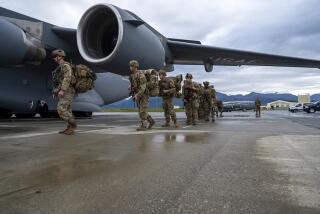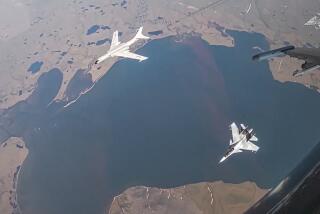U.S., Soviet Planes Share Airspace in Eye of Storm
- Share via
MIAMI — After a minor flap, U.S. and Soviet reconnaissance planes competing for a look at one of the most powerful storms in history agreed to share airspace inside Hurricane Gilbert today.
A third U.S. research plane also entered the cyclonic eye.
“It’s a busy hurricane out there,” Bob Sheets, director of the National Hurricane Center, said of the air traffic.
The Soviets flew at 12,000 feet and the Americans were at 10,000 feet, Sheets said at a news briefing. He also said a research plane from the U.S. National Oceanic and Atmospheric Administration was gathering data at 5,000 feet.
The U.S.-Soviet flap developed earlier in the day as Soviet pilots flying out of Cuba tried to reserve airspace over the hurricane, possibly hindering U.S. Air Force hurricane spotters.
Gathering Data for Cuba
The Soviets apparently were trying to gather information on the storm for the Cuban government. Cuba was still feeling the effects of Gilbert’s winds two days after the storm passed the island nation.
Forecasters at the hurricane center at first said the issue was resolved when U.S. officials agreed to share data gathered on the storm by American pilots with the Cuban government, but Sheets later said that the Soviet plane flew anyway and that its crew was in radio contact with the U.S. Air Force plane.
“They worked it out among themselves,” Sheets said.
In Washington, Air Force Pentagon spokesman Lt. Col. James Janette said, “This is the first time U.S. and Soviet pilots have communicated and cooperated in monitoring a hurricane.”
Sheets said he was told at 6 a.m. today that the Soviets had reserved an eight-hour block of time and a big chunk of space--from 3,500 feet to 19,000 feet--to fly research aircraft through Gilbert over international waters.
‘This Is Not Unusual’
Sheets said it was unclear how the Soviets made the reservation, although they claimed that it was done through the FAA Control Center in Houston, which coordinates air traffic in the Gulf of Mexico.
But Sheets said the U.S. plane entered the hurricane at 7 a.m. at an altitude of 10,000 feet, before the Soviet plane went up, and had time to do one of its tasks before moving out of the eye to a point about 100 miles away to await further instructions.
He said the crews of the planes then agreed to stay at the different altitudes.
More to Read
Sign up for Essential California
The most important California stories and recommendations in your inbox every morning.
You may occasionally receive promotional content from the Los Angeles Times.









